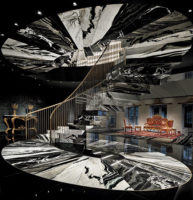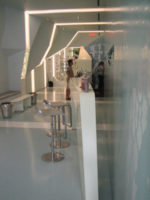Eight years after the French brothers Ronan and Erwan Bouroullec designed interiors for Kvadrat’s flagship showroom in Copenhagen, the high-end textile manufacturer’s 4,300-square-foot space in a 1950s redbrick warehouse was bursting at the seams. Founded in Denmark in 1968, Kvadrat has earned a global reputation as an industry leader in the upscale textile market, with Hella Jongerius, Frank Gehry, and Renzo Piano among its high-profile designer and architect collaborators. In recent years, innovation and international expansion has garnered the company huge growth, with annual sales leaping from $22.7 million in 1992 to $188.9 million in 2017. However, in Kvadrat’s prime harbor-front location in the Nordhavn district, a busy shipping port undergoing transformation into a modern residential and business quarter, this success translated into a serious shortage of space, and divided work teams. “Having sales downstairs and marketing upstairs was just not great for the atmosphere,” says Njusja de Gier, Kvadrat’s vice president of branding and communication. So the executives were quick to broker a deal when they learned of an available ground-floor property, double the size of what they had, in the building.
Additional Content:
Jump to credits & specifications
The 8,600-square-foot space benefits from an abundance of daylight, with expansive 13-foot-high by 7-foot-wide windows on three sides, one of those directly on the water. To carve out a new home, the Paris-based Bouroullec design studio was enlisted once more—leading to a unique situation. “Since we’ve been working with Kvadrat for a very long time, we know nearly all the people there,” says Erwan, who, along with his brother, has designed textiles and related interior products for the company.
The brothers devised a scheme with a highly flexible anodized-aluminum display system that allows virtually limitless options for elegantly and efficiently presenting fabrics and rugs throughout the showroom. Consisting of an 11-by-19-foot ceiling-mounted grid and chainlike rods dropping down to hold horizontal rails—think trapeze swing—the system spans the entire footprint of the space and allows large swaths of the textiles to be slung from varying heights and positions. “We can create different exhibitions as we please, and always make the system suitable for our needs,” says de Gier. “The aim is to change it twice a year, coinciding with new-product launches.”
On average, 15 different locations across the showroom are used to present products, in layered groups or alone. “We really wanted to make a tool, something useful,” Erwan notes. Rails, 9 to 16 feet in length, are intended to withstand up to 220 pounds. “Some of the carpets—say one that’s made of thick wool—can be very heavy,” he explains.
Decisions for the rest of the space were driven by a strong materiality to create a dialogue with the raw extremes of the industrial harbor. “It’s not Miami Beach—it’s Copenhagen! So, most of the time, it is windy and rainy, the kind of weather we used to have during our childhood in Brittany,” Ronan explains. Once an unloading area for containers carrying everything from bananas to steel, the raw space had concrete floors, which the designers retained. “If anyone had asked me to change it, I would have said no,” Erwan says. “It’s as important as the sea around it, with marvelous traces, polished by life.”
Relying on the textiles for color, the design team created a pristine white interior as a backdrop. Then they installed translucent ribbed-glass partitions to maintain the feel of an open floor plan and carve out semi-private zones for the showroom’s meeting and office areas, reception desk, I.T. room, kitchen, product library, and presentation tables. “There is a much better split between working space and showroom,” de Gier comments. The glass walls—one full-height, revealing the product library, the other partial, above a low, white-brick wall adjacent to the office area—create a central corridor and impart an ethereal luminescence due to the diaphanous material’s ability to capture sunlight. “Though the glass is not handmade, it is beautiful in its irregularity, sometimes with little bubbles inside,” Erwan notes. Oak flooring beneath the workstations is soft underfoot and dampens sound, while milk-white glass desk lamps provide a gentle glow.
The brothers incorporated their furnishings throughout the showroom: plastic Belleville chairs are paired with a large custom table in one meeting area, and Alcove high-backed sofas provide sheltered nooks in two others, handy for the staff’s frequent phone meetings, de Gier notes. They also used Kvadrat products. Ceiling, cabinets, reception desk, and office desks are all made of an upcycled rigid textile board, a blend of thermoplastic and the company’s cotton and wool scraps. The panels reveal a dedication to sustainability and demonstrate the innovative use of manufacturing castoffs.
Moving to the airy, open office from a traditional one, with the typical freestanding display shelves and racks confined to a separate area, was a revelation for the company’s 19 Copenhagen-based employees, who are now surrounded by the company’s materials. “So many of them told me that they had never seen the textiles at such a large scale,” says Erwan. The sheer luxury of so much fabric hanging for both sales and décor has proven to be a valuable asset for the new showroom, appealing to staff and clients alike.
Back to Good Design Is Good Business 2018
CreditsArchitect: Erwan and Ronan Bouroullec, Paris, France, www.bouroullec.com
Consultants: Generel Project Manager: Jacob Manz, Kvadrat Product developer: Claus Molgaard Lightning: Flos Scandinavia
General contractor: Syncro Aps
Photographer: Michel Giesbrecht & Studio Bouroullec |
SpecificationsGlazing Glass: Linit U-glass panels P26 Prismasolar by Lamberts
Doors Special doors: Custom produced glass doors by Zederkop
Interior Finishes Acoustical ceilings: Kvadrat Soft Cells Suspension grid: Display System specially designed and produced by Erwan and Ronan Bouroullec with Kvadrat Cabinetwork and custom woodwork: Custom produced in Really Solid Textile Board Raised flooring: Dinesen heart oak floors Special interior finishes unique to this project: Brick walls built on site
Furnishings Office furniture: Tyde tables in Really Solid Textile Board specially designed and produced by Bouroullec & Vitra Chairs: ID chairs by Vitra, Belleville chairs by Bouroullec & Vitra Tables: CYL tables by Bouroullec & Vitra Upholstery: Kvadrat textiles: Hallingdal 65 Other furniture: Alcove Plume sofas by Bouroullec & Vitra, Palissade benches by Bouroullec & Hay, Steelwood chairs by Bouroullec & Magis
Lighting Downlights: Running Magnets track and spots by Flos Tasklighting: Kelvin LED by Flos Dimming system or other lighting controls: Dali system by Flos
Plumbing Toilet fixtures: Vola Tiles on walls and floors: Pico by Bouroullec & Mutina
Energy Other unique products that contribute to sustainability: Really Solid Textile Board – used for custom built cabinets, office desks and partitions throughout Add any additional building components or special equipment that made a significant contribution to this project: A specially designed and produced showroom Display System by Bouroullec and Kvadrat. A Display System for hanging and exhibiting large size textiles and rugs and a Shelving System for displaying and showcasing Kvadrat products. |









Post a comment to this article
Report Abusive Comment